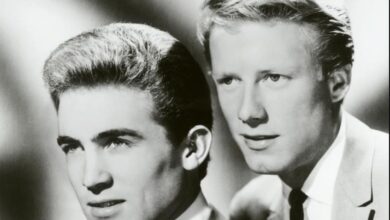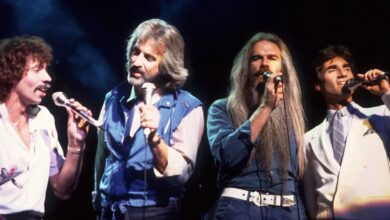Statler Brothers’ “The Little Brown Church In The Vale” Rekindles Gospel Tradition with Country Harmony in 1995
Released in 1995 as part of their beloved Amen album, the Statler Brothers’ rendition of “The Little Brown Church in the Vale” breathed new life into a 19th-century hymn that had already endured generations of American worship and folk tradition. While the song itself had long been a staple in rural churches and hymnbooks, the Statlers’ version gave it renewed national attention. Though it wasn’t a mainstream chart hit, its cultural weight was undeniable, offering a bridge between old-time gospel reverence and contemporary country accessibility.
By the time of this recording, the Statler Brothers were seasoned veterans, with a career spanning more than four decades. Formed in Staunton, Virginia in 1955, the group had originally performed as the Four Star Quartet, primarily singing Southern gospel. They rose to prominence in the 1960s as backup singers for Johnny Cash, quickly gaining acclaim for their tight four-part harmonies and down-home storytelling. Blending humor, nostalgia, and faith, they carved a distinct niche that allowed them to thrive in both secular and sacred musical spaces.
The story behind “The Little Brown Church in the Vale” begins in 1857, when Dr. William S. Pitts, inspired by a picturesque spot in Iowa, composed the hymn envisioning a quaint church nestled in a valley. The church, built several years later on that very spot, became a pilgrimage site for hymn lovers. While the song had been recorded numerous times in the early-to-mid 20th century, it had not been widely revisited by modern acts until the Statlers chose to revive it, honoring its simple beauty and spiritual charm.
In the studio, the Statler Brothers approached the recording with characteristic warmth and restraint. The arrangement was traditional yet polished, highlighting their vocal precision without overshadowing the humble roots of the song. Acoustic guitars, a soft organ bed, and minimal percussion framed their harmonies, keeping the focus on the vocals. Don Reid’s smooth lead was supported seamlessly by Harold Reid’s deep bass, Phil Balsley’s steady baritone, and Jimmy Fortune’s clear tenor, creating the textured vocal tapestry fans had come to love.
Though it wasn’t intended for radio play in the Top 40 sense, the song quickly found a home on gospel stations, church playlists, and community gatherings. Fans old and new were drawn to the familiar melody and the authenticity of the Statlers’ delivery. It became one of the standout tracks from the Amen album, which itself was a tribute to the group’s gospel roots. While the track didn’t climb charts, it didn’t need to—its power lay in its sincerity, and its message found its way into homes across the country.
“The Little Brown Church in the Vale” also served as a cultural statement at a time when country music was increasingly moving toward pop influences. The Statlers’ choice to embrace traditional gospel spoke volumes about their priorities as artists. In staying true to their roots, they re-centered the spiritual themes that had once been at the heart of country music. The song connected deeply with audiences who felt that country’s soul was being lost in commercial trends.
For the Statler Brothers, including this hymn on their album reaffirmed their gospel credentials and extended their relevance into the 1990s. As their mainstream chart presence waned with age, songs like this ensured they remained beloved figures in the gospel and traditional country communities. It gave them opportunities to perform at faith-centered festivals, church events, and family-focused venues that appreciated their mix of reverence and harmony.
The impact of their version extended beyond their own careers. It inspired other country and gospel acts to revisit older hymns, resulting in a quiet resurgence of faith-based songs throughout the late ’90s and early 2000s. Artists such as Alan Jackson and Randy Travis would go on to record their own collections of hymns, following in the Statlers’ footsteps by blending old standards with modern production and wide accessibility.
While “The Little Brown Church in the Vale” has been covered many times—from the Carter Family to Jim Ed Brown—it was the Statler Brothers’ rendition that brought the hymn back into national awareness. Their version was neither too ornate nor too stripped down, finding a balance that respected the hymn’s origins while resonating with contemporary listeners. Their interpretation became the standard for many church choirs and gospel quartets seeking to revive the song.
Around the time of this release, the group was nearing retirement. Lew DeWitt, a founding member who had retired in the early ’80s due to illness, passed away in 1990. The group, now with Jimmy Fortune filling the tenor role, used songs like this to reaffirm their legacy and to honor the spiritual side of their identity. It was a way to say goodbye not with grandeur, but with grace, humility, and reverence.
Over the years, the song has maintained its place in the Statlers’ legacy. It remains a fan favorite in their catalog and is regularly featured on retrospectives, gospel compilations, and tribute albums. Its longevity reflects not just the enduring appeal of the original hymn, but the enduring trust audiences placed in the Statlers to deliver it with care and conviction.
The song also helped solidify the viability of gospel content in the mainstream market. While it was not a commercial single, its warm reception proved that audiences still had a strong appetite for sacred music—especially when delivered with heartfelt precision. This laid the groundwork for greater acceptance of gospel-country hybrids in future decades, influencing labels and producers to take chances on similar projects.
Although the Statler Brothers officially retired in 2002, their version of “The Little Brown Church in the Vale” lives on. It continues to be used in services, celebrations of life, and community singalongs—wherever people gather to reflect, remember, or give thanks. The group’s ability to bring new light to a 19th-century hymn is a testament to the enduring power of harmony, sincerity, and spiritual expression in American music.
In the end, “The Little Brown Church in the Vale” isn’t just a song—it’s a symbol of the Statler Brothers’ quiet mission to preserve the values and voices of rural America. Their 1995 rendition wasn’t about reinvention—it was about re-connection. In choosing to honor a simple church song from another century, they offered a timeless reminder: that sometimes, the greatest resonance comes not from innovation, but from remembering who we are and where we’ve been.



